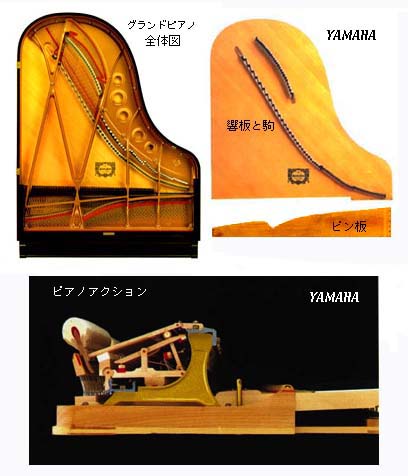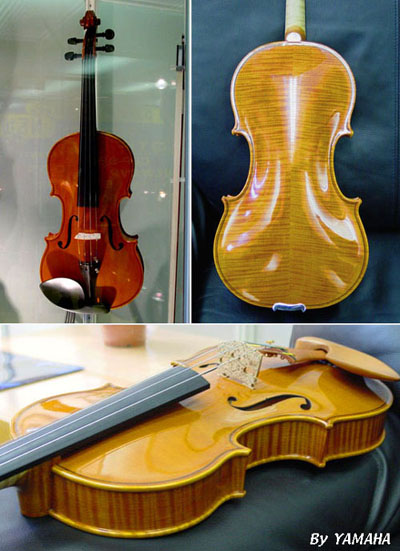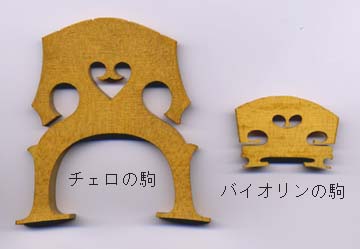
8. Maple Use for Lumber and Furniture ........ Japanese
Hard maple and soft maple
In the catalog of the American Hardwood Export Council (in Japanese), we can see the description as follows:
" 5 species are important among 13 species in the USA, and among 5, 2 species belong to hard maples, such as sugar maple and black maple, and 3 species belong to soft maples, such as red maple, silver maple and boxelder. Soft maples are 25% softer than hard maples in hardness. Hard maples are generally heavier, stronger, stiffer and stronger against impulse. Maples have a better character for machine working than any other wood among
broad-leaved trees. " (my translation)Both the hard maples and the soft maples are much used for panels of furniture and wall, flooring and cabinets.
Birds' eye maple
Bird's eye maple has the characteristic pattern which is a dotted figure like a bird's eyes, and curly maple has a curled figure. They are used for furniture and musical instruments.
Let me explain a little here.
These patterns, such as grain, figure and texture, are synonyms but there seem to be some different nuances respectively.
" Grain is regarded as an all-inclusive expression on the surface appearance of the wood structure considering those which appear on the cut surface, such as the condition of the growth layer, the arrangement, the size and the property of cells, and the degree of plane finishing, and containing figures, namely, the pattern design on the surface. But some figures have no relation to the wood structure and are caused only by the change of colors. In various kinds of the grains, wavy grain or curly grain are formed by the wavy arranging of the longitudinal components, resulting in curly figures. Above all, the curly figure of maples is well-known and is frequently used for the back plate of the violin, and is often called Fiddle back figure, and an especially fine and beautiful one is called the Ram's horn figure." (quoted from "Genshoku Mokuzai Daizukan (Hoiku-sha)", my translation )
9. Maple Use for musical instruments
Use for Pianos
Hard maples and itaya-kaede (A.mono) from Japan are used for piano parts, such as cabinets, the bridges on the soundboard and the parts of the striking mechanism, what we call the piano action. Soft maples are used for the legs of the pianos and chairs.
Photos below were offered by YAMAHA Corporation.


Use for Violins
The top plate is traditionally made of spruce which has high efficiency of sound emission, and the back plate of maples plays a part in the structure's strength as well as in sound. The viola and the cello also have the same composition. For the bridge supporting strings, maple is used, too.


The left for cello, the right for violin
Use for fagotts
The fine quality materials selected from those of plane maples are used for fagotts.
Plane maple(Acer pseudoplatanus) is known as street trees in Europe.

We should not ignore the acoustic property for the materials of the musical instruments, which require evaluation, selection and severe management of the materials.
The lumber character (compared with general industrial materials)
1. Specific Young's modulus is great ; strong for light, velocity of transmission is great
2. To have orthotropy ; property difference among 3 directions
3. Properties are not even, and have dispertion(deviation)
4. To have moisture absorption, and properties will change with moisture content
5. Easy to work for cutting, planing, gluing and finishing
6. To have the endemic impulse absorption and decaying character
7. To have beautiful appearance and excel in painting
8. Comparatively cheap in cost except part of the scarce woodIn this way, the lumber has superior properties and changeable fuzzy factors which are different from the artificial materials, such as metals and plastics. We will utilize orthotropy for the soundboard of the instruments, but on the other hand we use as the rotary cores for the improvement of the orthotropy. For pillars as solid elements we apply a traditional knowledge to prevent cracking by making a slit on its opposite side of the front face. For uneveness we use wood in the form of plywood, laminated veneer lumber and glue laminated lumber for the purpose of making their dispertion minimum as the elements which support the strength of structures. For the management of moisture content, natural drying and artificial drying are used, and for preventing moisture exchange we utilize coating treatment.
Generally, lumber is used for construction, houses, furniture and musical instruments. We would like to say that lumber is a type of cyclic and environment-adaptable material, which will be valuable to human beings and the earth also in the future as long as we maintain the balance between planting and cutting down.